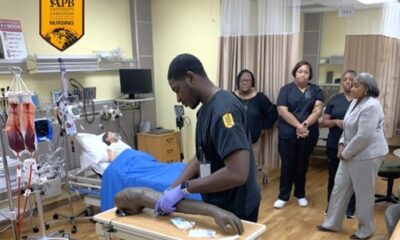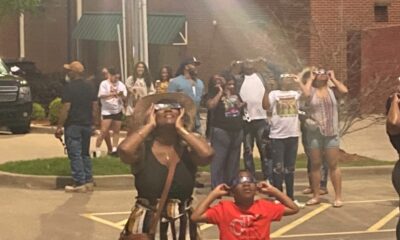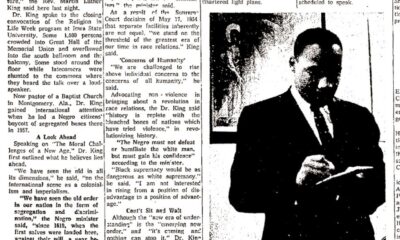Featured
What Black America Can Learn from the 1918 Pandemic

The federal government is extending its stay-at-home guidelines which were set to expire Monday until April 30, a decision heralded by healthcare officials and reminiscent of a strategy employed during the deadly 1918 Spanish flu pandemic.
According to a report on the National Institutes of Health website, social distancing played a key role in saving lives in 1918.
“Cities where public health officials imposed multiple social containment measures within a few days after the first local cases were recorded cut peak weekly death rates by up to half compared with cities that waited just a few weeks to respond,” the report outlined. “Overall mortality was also lower in cities that implemented early interventions, but the effect was smaller.”
The report includes a name closely associated with COVID-19: Dr. Anthony Fauci. Fauci, director of the NIH’s National Institute of Allergy and Infectious Disease, approved funding for the report.
In the report, Fauci stated, “These important papers suggest that a primary lesson of the 1918 influenza pandemic is that it is critical to intervene early. While researchers are working very hard to develop pandemic influenza vaccines and increase the speed with which they can be made, nonpharmaceutical interventions may buy valuable time at the beginning of a pandemic while a targeted vaccine is being produced.”
Fauci serves on the White House Coronavirus Task Force and is known for advocating for early social distancing measures even as critics were downplaying the threat of the new coronavirus. He is credited with also urging the Trump Administration to maintain the guidelines established in mid-March, famously remarking, “The virus sets the timeline.”
Black Americans Vulnerable During Pandemics
The NIH also studied the impact of the 1918 pandemic on Black America and found a community reeling from an already overwhelmed healthcare system and fewer resources due to Jim Crow-era racism.
According to the report, “When the 1918 influenza epidemic began, African American communities were already beset by many public health, medical, and social problems, including racist theories of black biological inferiority, racial barriers in medicine and public health, and poor health status.”
This storm of desperate odds struck Black America when “separate but equal” medical institutions existed. Medical professionals in Black America and leaders like Booker T. Washington pushed for more attention to sanitation and good hygiene, but resources were scarce. According to the NIH, media reports in Black newspapers may have painted an inaccurate view of the virus’s impact, sharing an excerpt from the Baltimore Afro-American…“while the death rate from the epidemic…is not as high as the white death rate, colored people are far from being immune of the disease.”
At the outset of COVID-19, a dangerous myth circulated and promoted the idea of Black immunity. High-profile celebrities like actor Idris Elba and NBA superstars, Kevin Durant and Rudy Gobert, who are recovering from the coronavirus refuted the rumor and urged caution.
Dr. Sean Campbell, a physician with Stony Brook Hospital in Stony Brook, New York, remarked, “Why would you take a chance?”
More at Risk?
A recent New York Times report raises the specter of widespread infections in “smaller communities like Greenville, Miss., and Pine Bluff, Ar., and large cities like New Orleans, Milwaukee, Detroit and Chicago.” The cities listed in the Times report have large Black populations.

In Pine Bluff, Mayor Shirley Washington and other city leaders implemented a curfew from 9:00 p.m. until 5:00 a.m. A daytime juvenile curfew is also in place. Law enforcement authorities plan to issue fines for violations.
“We have to get our community to understand that this is serious,” Police Chief Kelvin Sergeant said during a local radio interview. “But, at some point, which I’m saying today, ‘We’re going to have to stop warning and start taking it to the next level.’”
The city’s new guidelines began Sunday after businesses considered non-essential continued to operate and gatherings of more than 10 came to the attention of authorities.
“A lot of COVID-19 tests are being administered, and most of our tests are coming back negative. However, numbers can change drastically overnight. Therefore, we want to be as aggressively proactive as we can,” Mayor Shirley Washington said.
Larger cities were also moving quickly to reinforce their social containment message.
Chicago mayor, Lori Lightfoot, said in a Facebook video, “I care about people in the city I may never meet just as I care about my own family and my beloved friends and my neighbors that I see every day…resiliency and resolve are baked into our DNA. As a people, this is our moment to prove to ourselves and to a nation that in Chicago we may get bent but we will never get broken.”
And, in Michigan, Governor Gretchen Whitmer is designating Detroit’s convention center, the TCF Center, as a field hospital to prepare for an apparent increase in coronavirus cases, resulting in the cancellation of the 2020 North American International Auto Show held annually at the center.
“The health and welfare of the citizens of Detroit and Michigan is paramount. TCF Center is the ideal location for this important function at this critical and unprecedented time,” NAIAS Executive Director Rod Alberts stated in a memo.
Whitmer is also considering an early-release for low-risk prisoners.
It’s been over 100 years since the 1918 pandemic claimed millions of lives. As nations rush to contain the coronavirus, several facts distinguish 1918 from today: there is not a World War underway with troops cloistered in tight wartime conditions and moving en masse through Europe, medical advancements have contributed to a healthier population, and communication via the internet and social media allow governments to inform citizens with unprecedented speed. These developments in concert with an aggressive adherence to the social containment measures first widely introduced in 1918 offer a more hopeful outlook for today.

-

 Black History5 months ago
Black History5 months agoThe untold story of a Black woman who founded an Alabama hospital during Jim Crow
-

 Featured9 months ago
Featured9 months ago‘No Closure’ In Town Where Five Black Residents Were Either Murdered, Died Suspiciously Or Are Missing
-

 Black History10 months ago
Black History10 months agoBlack History Lost and Found: New Research Pieces Together the Life of Prominent Texas Surgeon and Activist
-

 Featured9 months ago
Featured9 months agoFounder of “The Folding Chair” Podcast Calls Montgomery’s Brawl ‘Karma’
-

 Featured9 months ago
Featured9 months agoThousands ‘Live Their Dream’ During National Black Business Month
-

 Featured11 months ago
Featured11 months agoJuneteenth And ‘246 Years Of Free Labor’ Are Key To Conversations About Reparations









